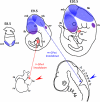The Roles of Glutathione Peroxidases during Embryo Development
- PMID: 21847368
- PMCID: PMC3148772
- DOI: 10.3389/fnmol.2011.00012
The Roles of Glutathione Peroxidases during Embryo Development
Abstract
Embryo development relies on the complex interplay of the basic cellular processes including proliferation, differentiation, and apoptotic cell death. Precise regulation of these events is the basis for the establishment of embryonic structures and the organ development. Beginning with fertilization of the oocyte until delivery the developing embryo encounters changing environmental conditions such as varying levels of oxygen, which can give rise to reactive oxygen species (ROS). These challenges are met by the embryo with metabolic adaptations and by an array of anti-oxidative mechanisms. ROS can be deleterious by modifying biological molecules including lipids, proteins, and nucleic acids and may induce abnormal development or even embryonic lethality. On the other hand ROS are vital players of various signaling cascades that affect the balance between cell growth, differentiation, and death. An imbalance or dysregulation of these biological processes may generate cells with abnormal growth and is therefore potentially teratogenic and tumorigenic. Thus, a precise balance between processes generating ROS and those decomposing ROS is critical for normal embryo development. One tier of the cellular protective system against ROS constitutes the family of selenium-dependent glutathione peroxidases (GPx). These enzymes reduce hydroperoxides to the corresponding alcohols at the expense of reduced glutathione. Of special interest within this protein family is the moonlighting enzyme glutathione peroxidase 4 (Gpx4). This enzyme is a scavenger of lipophilic hydroperoxides on one hand, but on the other hand can be transformed into an enzymatically inactive cellular structural component. GPx4 deficiency - in contrast to all other GPx family members - leads to abnormal embryo development and finally produces a lethal phenotype in mice. This review is aimed at summarizing the current knowledge on GPx isoforms during embryo development and tumor development with an emphasis on GPx4.
Keywords: anti-oxidative defense; reactive oxygen species; selenium; teratogenesis.
Figures



Similar articles
-
Expression of inactive glutathione peroxidase 4 leads to embryonic lethality, and inactivation of the Alox15 gene does not rescue such knock-in mice.Antioxid Redox Signal. 2015 Feb 1;22(4):281-93. doi: 10.1089/ars.2014.5967. Epub 2014 Dec 19. Antioxid Redox Signal. 2015. PMID: 25313597
-
Redox control in mammalian embryo development.Antioxid Redox Signal. 2010 Sep 15;13(6):833-75. doi: 10.1089/ars.2009.3044. Antioxid Redox Signal. 2010. PMID: 20367257 Review.
-
Glutathione peroxidase 4 maintains a stemness phenotype, oxidative homeostasis and regulates biological processes in Panc‑1 cancer stem‑like cells.Oncol Rep. 2019 Feb;41(2):1264-1274. doi: 10.3892/or.2018.6905. Epub 2018 Dec 6. Oncol Rep. 2019. PMID: 30535490
-
The role of selenium peroxidases in the protection against oxidative damage of membranes.Chem Phys Lipids. 1987 Jul-Sep;44(2-4):255-76. doi: 10.1016/0009-3084(87)90053-3. Chem Phys Lipids. 1987. PMID: 3311419 Review.
-
Characterization of phospholipid hydroperoxide glutathione metabolizing peroxidase (gpx4) isoforms in Coho salmon olfactory and liver tissues and their modulation by cadmium.Aquat Toxicol. 2012 Jun 15;114-115:134-41. doi: 10.1016/j.aquatox.2012.02.025. Epub 2012 Mar 3. Aquat Toxicol. 2012. PMID: 22446825 Free PMC article.
Cited by
-
Glycolytic activity is required for the onset of neural plate folding during neural tube closure in mouse embryos.Front Cell Dev Biol. 2023 Jul 3;11:1212375. doi: 10.3389/fcell.2023.1212375. eCollection 2023. Front Cell Dev Biol. 2023. PMID: 37465012 Free PMC article.
-
Listening to mother: Long-term maternal effects in mammalian development.Mol Reprod Dev. 2020 Apr;87(4):399-408. doi: 10.1002/mrd.23336. Epub 2020 Mar 22. Mol Reprod Dev. 2020. PMID: 32202026 Free PMC article. Review.
-
Fetal Programming Is Deeply Related to Maternal Selenium Status and Oxidative Balance; Experimental Offspring Health Repercussions.Nutrients. 2021 Jun 18;13(6):2085. doi: 10.3390/nu13062085. Nutrients. 2021. PMID: 34207090 Free PMC article. Review.
-
Effects of High Intensity Interval Training on Pregnant Rats, and the Placenta, Heart and Liver of Their Fetuses.PLoS One. 2015 Nov 13;10(11):e0143095. doi: 10.1371/journal.pone.0143095. eCollection 2015. PLoS One. 2015. PMID: 26566220 Free PMC article.
-
Nrf2 and Nrf2-related proteins in development and developmental toxicity: Insights from studies in zebrafish (Danio rerio).Free Radic Biol Med. 2015 Nov;88(Pt B):275-289. doi: 10.1016/j.freeradbiomed.2015.06.022. Epub 2015 Jun 28. Free Radic Biol Med. 2015. PMID: 26130508 Free PMC article. Review.
References
-
- Arner E. S. (2009). Focus on mammalian thioredoxin reductases – important selenoproteins with versatile functions. Biochim. Biophys. Acta 1790, 495–526 - PubMed
-
- Avissar N., Eisenmann C., Breen J. G., Horowitz S., Miller R. K., Cohen H. J. (1994a). Human placenta makes extracellular glutathione peroxidase and secretes it into maternal circulation. Am. J. Physiol. 267, E68–E76 - PubMed
-
- Avissar N., Ornt D. B., Yagil Y., Horowitz S., Watkins R. H., Kerl E. A., Takahashi K., Palmer I. S., Cohen H. J. (1994b). Human kidney proximal tubules are the main source of plasma glutathione peroxidase. Am. J. Physiol. 266, C367–C375 - PubMed
LinkOut - more resources
Full Text Sources
Miscellaneous

